Guitar modes can be viewed as scales on their own since the notes in each mode are separated by a given interval pattern.
However, they would not exist on their own, since they are part of a bigger scale. So it's fair to say that all modes are scales, but NOT all scales are modes 🙂
Now that I have you confused, let's look at the most used and known modal system on the guitar, the 7 modes of the major scale.
The main concept is fairly simple:
Each mode starts off of a different note of the major scale, thus each of the 7 guitar modes is a derivative of the major scale.
This may seem like a small change, but you’ll hear that because of these one-note changes, each mode will have a distinctive atmosphere and mood to it, which you can use in your music.
Ionian Mode
The Ionian mode is the first mode, it’s another name for the major scale itself. The intervals of Ionian mode are:
1 W 2 W 3 H 4 W 5 W 6 W 7 H 8(1)
| Ionian mode | Details |
|---|---|
| Description: | This scale is used as a base scale from which other modes and scales come. |
| Quality: | Happy, Upbeat |
| Musical Styles: | Rock, Country, Jazz, Fusion |
| Chords: | Major Chords |
| Intervals: | W-W-H-W-W-W-H |
Remember that this is a movable scale, so you can move this shape all over the fretboard.
As you can see, the Ionian mode consists of major notes, therefore it can be used to play major chords, which are comprised of the 1st, 3rd, 5th degree. Notice, that you get the G major chord if you use these degrees.
The 2nd and 6th-degree notes are extensions of major chords. Notice, that if you use the 1st, 2nd, 3rd, 5th, and 6th-degree notes, you get the major pentatonic scale.
Using the 4th-degree note can sound a bit out of unison from the other notes, but if you use it as a passing tone (bridge) in arpeggios, for example, it will sound great.
If you add the 7th-degree note, you’ll be able to use Ionian mode with major 7th chords as well.
Dorian Mode
Dorian mode roots off of the second note of the major scale (Ionian mode). Dorian works well with minor chords, as it has 2 flat notes. The intervals of Dorian mode are:
1 W 2 H b3 W 4 W 5 W 6 H b7 W 8(1)
| Dorian Mode | Details |
|---|---|
| Description: | This is the major scale with a flat 3rd and 7th note |
| Quality: | Jazzy, Sophisticated, Soulful |
| Musical Styles: | Jazz, Fusion, Blues, and Rock |
| Chords: | Minor, Minor 7th, Minor 9th |
| Intervals: | W-H-W-W-W-H-W |
As you can see, Dorian uses 2 flat notes, a flat 3rd, and a flat 7th. The minor 3rd (flat 3rd) gives the Dorian mode a minor scale mood
The use of the flat 3rd with the major 6th naturally gives this mode a Jazzy flavor (jazz musicians use the major 6th note with minor scales often), try it for yourself!
You can play nice minor sounding arpeggios if you integrate the rest of the notes as well, try using the 6th as a passing tone.
Phrygian Mode on Guitar
Phrygian mode begins off of the third interval of the major scale, therefore it is the 3rd mode. The intervals of Phrygian mode are the following:
1 H b2 W b3 W 4 W 5 H b6 W b7 W 8(1)
| Phrygian Mode | Details |
|---|---|
| Description: | This is the major scale with a flat 2nd, 3rd, 6th, and 7th note |
| Quality: | Spanish sound |
| Musical Styles: | Flamenco, Fusion, Speed Metal |
| Chords: | Minor, Minor 7th |
| Intervals: | H-W-W-W-H-W-W |
You’ll notice that this mode has the minor 3rd and 7th degrees as well, therefore it will be suited for minor chords, especially minor 7th chords.
The really interesting thing about this mode is the minor 2nd-degree note. This gives the Phrygian an exotic flavor, many musicians associate it with Spanish and Middle-Eastern sounding music. Try it for yourself, arpeggiate this scale with emphasis on the 2nd degree. Don’t overdo it though, the 2nd would normally just be a passing tone, you’ll need to resolve to a stable tone after you play it.
Also, experiment with removing the minor 3rd altogether. It will place greater emphasis on the flat 2nd.
Lydian Mode
Lydian mode begins off of the fourth note of the major scale and is therefore the fourth mode. The intervals of Lydian are the following:
1 W 2 W 3 W #4 H 5 W 6 W 7 H 8(1)
| Lydian Mode | Details |
|---|---|
| Description: | This is the major scale with a sharp 4th note |
| Quality: | Airy, Mesmerising |
| Musical Styles: | Jazz, Fusion, Rock, Country |
| Chords: | Major, Major 7th, Major 9th, Sharp 11th |
| Intervals: | W-W-W-H-W-W-H |
You’ll notice that the only difference from the major scale is the sharpened 4th-degree note. This makes all the difference though, since playing this mode really creates a mesmerizing atmosphere.
Since there are no flat 3rd or 5th notes in this scale, so we know that it can be used to play major chords and their extensions.
Mixolydian Mode on Guitar
The Mixolydian Mode begins off of the 5th-degree note of the major scale and is the fifth mode. The intervals of Mixolydian are:
1 W 2 W 3 H 4 W 5 W 6 H b7 W 8(1)
| Mixolydian Mode | Details |
|---|---|
| Description: | This is the major scale with a flat 7th note |
| Quality: | Bluesy |
| Musical Styles: | Blues, Country, Rockabilly, and Rock |
| Chords: | Dominant Chords |
| Intervals: | W-W-H-W-W-H-W |
This scale is different from the major scale in that it has a flattened 7th degree, also called dominant 7th. This change gives the Mixolydian mode a bluesy, country music style.
This may seem like a small change, but it gives the mode a totally different atmosphere, and it also means that you won’t be able to play major 7th chords, only dominant 7th chords over this scale.
Aeolian Mode
Aeolian begins off of the 6th note of the major scale, so it's our 6th mode. Aeolian is better known as the natural minor scale and is the basis of the harmonic and melodic minor scales. The intervals of Aeolian are:
1 W 2 H b3 W 4 W 5 H b6 W b7 W 8(1)
| Aeolian Mode | Details |
|---|---|
| Description: | This is the major scale with a flat 3rd, 6th, and 7th note |
| Quality: | Sad, Sorrowful |
| Musical Styles: | Pop, Blues, Rock, Heavy Metal, Country, Fusion |
| Chords: | Minor Chords |
| Intervals: | W-H-W-W-H-W-W |
The flattened 3rd makes this a minor mode and is therefore compatible with minor chords. The flattened 7th-degree note is a natural tone (as in the other minor modes as well).
You should also know how the flat 7th is a natural tone used in the minor modes.
The minor 6th note should be used as a passing tone, as it created a sort of tense atmosphere (you’ll hear this mode with the flat 6th used in horror flicks a lot). Try it for yourself, arpeggiate the scale and add the flat 6th here and there as a passing note, resolving to more stable notes (1,3,5,7).
Locrian Mode
Locrian is the 7th mode, and begins off of the 7th note of the major scale. The intervals of Locrian mode are the following:
1 H b2 W b3 W 4 H b5 W b6 W b7 W 8(1)
| Locrian Mode | Details |
|---|---|
| Description: | This is the major scale with a flat 2nd, 3rd, 5th, 6th, and 7th note |
| Quality: | Sinister |
| Musical Styles: | Jazz, Fusion |
| Chords: | Diminished, Minor 7th Flat Fives |
| Intervals: | H-W-W-H-W-W-W |
As you can see, Locrian is a minor mode due to the flat 3rd-degree note, meaning it will suit minor chords. The flattened 5th degree will add a diminished sound, so it suits minor diminished 5th chords as well.
Try arpeggiating this scale, you’ll see that it has a very tense, dark, almost sinister mood to it. Most musicians resolve to a less tense mode in the same key, after playing Locrian. Try it, arpeggiate Locrian then resolve to Ionian (major scale) in the same key, you’ll see that it sounds very natural.
Connecting Guitar Modes – One with the Universe
After reading the above, you should be familiar with the 7 modes of the major scale:
- Ionian
- Dorian
- Phrygian
- Lydian
- Mixolydian
- Aeolian
- Locrian
We know that each of the modes starts off with a specific note of the major scale, which means that all of these modes will be connected. Remember the major scale, and how it looked when you spread all of its notes along the fretboard?
Have a look at it again below (C major scale), and notice the notes on the low E string as the modes we just learned, as well as the patterns above the mode roots:

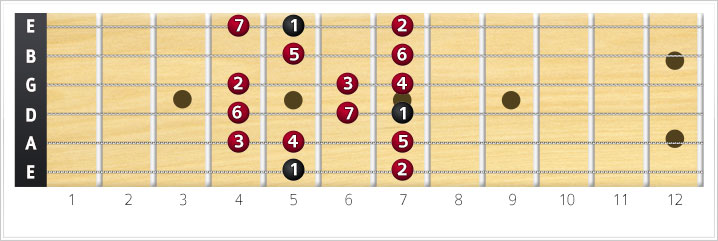
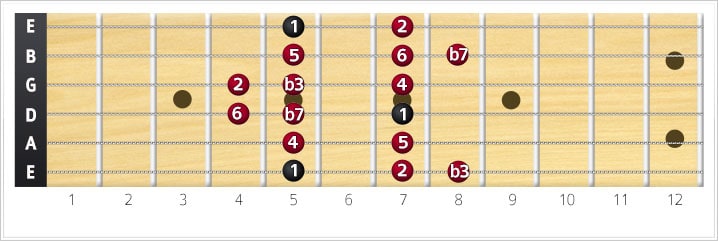
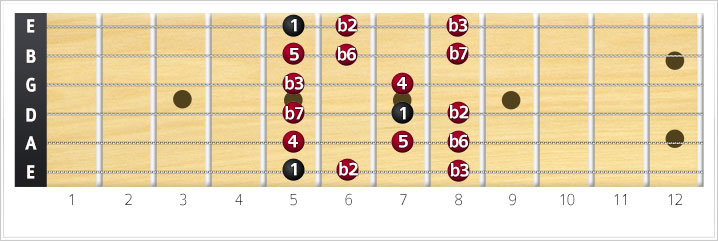
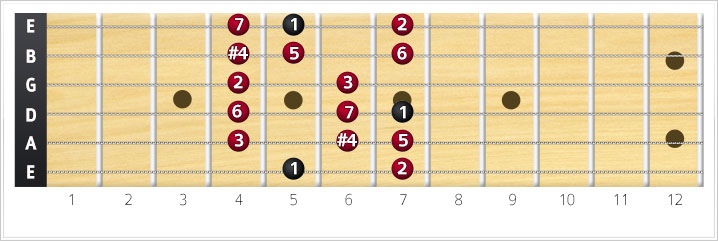
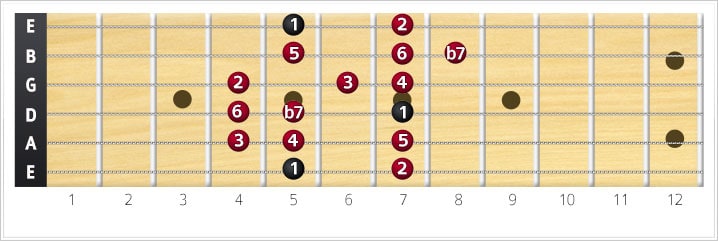
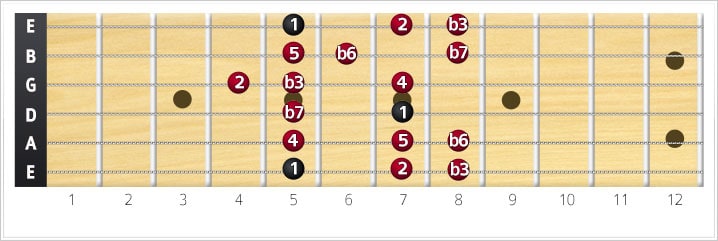
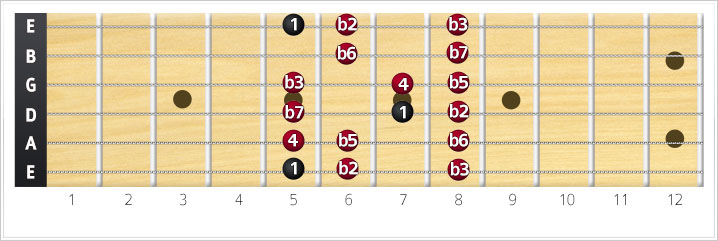
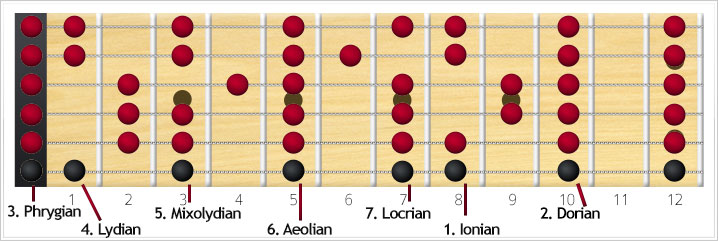
But yet you show all modes starting on the fifth fret instead of the 7 different positions.
There is an image at the bottom of post that shows the modes connected, I think that is what you’re looking for.
Hello,
Thanks for putting this page together. These pictures of the different modes we’re the best ones I’ve found.
Thanks again